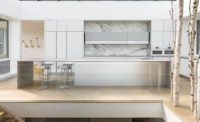Cedar Street Residence












| Photo © Bill Timmerman |
Maria and Matthew Salenger have no fear of suburbia. When the couple, who are both architects, returned to the Phoenix area in 1999 following graduate studies in London, they embraced their surroundings by purchasing a non descript 1,100-square-foot, three-bedroom 1954 ranch house in the middle-class suburb of Tempe.
But that’s where their “going native” stopped. Removing most of the interior walls, the couple created an open living space and built two basic steel-and-fiberglass sleeping pods in the backyard. With the birth of their son in 2008, however, this living arrangement proved impractical. Over the next year, the couple drew up about 50 different schemes for adapting the house to their new lifestyle (as well as designing houses for other prospective sites). While recognizing that designing for themselves presented the opportunity to flex their creative muscles, they, like their clients, struggled with the reality of resale value. “We almost hired a friend as our architect,” says Matthew. “We couldn’t come to a meeting of the minds.” Instead, the couple surveyed over 30 friends of friends, asking about their programmatic needs and their dream houses. The consensus was for three bedrooms and a “great room,” and “85 percent said they wanted a courtyard or atrium,” adds Matthew. The couple already knew that a secondary structure (which contains living and studio space) would need to accommodate separate day and night functions. “So the house started to design itself as a big, clean, open box,” says Matthew.
The team dismantled the pods and repurposed elements for the new construction. “It was a challenge creating something that would be definitive of who we are as designers,” Matthew says, “especially for Maria and me, who don’t like to be pinned down.” The new volume connects to the original house via steel-framed walkways with polycarbonate roofing and tempered acid-etched glass walls, which provide privacy from the neighbors and protection from the elements while rendering the courtyard an integral part of the house. The focal point is a 1,600-square-foot patch of turf, a fitting nod to the suburban archetype as well as a good place to play or host a party. Inside, mobile millwork can be reconfigured to expand and contract living and sleeping areas as needs change. “This space is always flexible and changing. Everything has to be transformable because our lives are not set,” says Matthew.








